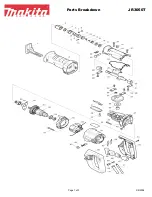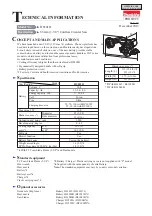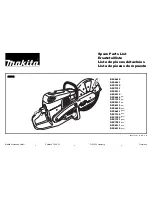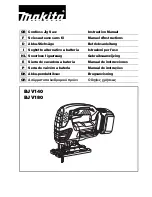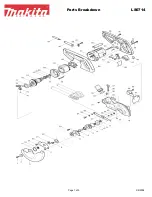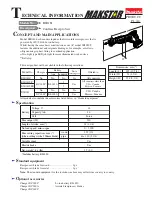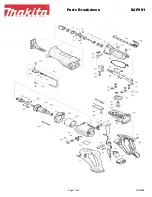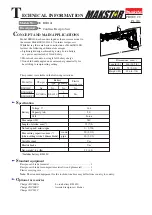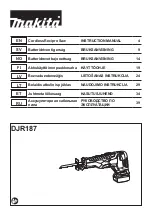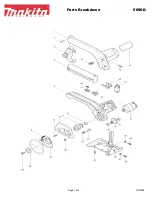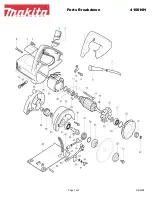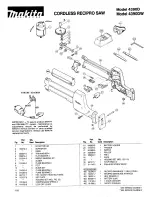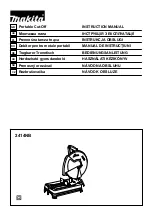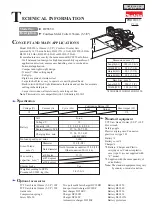
22 − English
OPERATION
Place the workpiece flat on the miter table with one edge
securely against the fence. If the board is warped, place
the convex side against the fence. If the concave edge
of a board is placed against the fence, the board could
collapse on the blade at the end of the cut, jamming the
blade.
See Figures 39 - 40.
When cutting long pieces of lumber or molding, support
the opposite end of the stock with a roller stand or with
a work surface level with the saw table.
See Figure 34.
Align cutting line on the workpiece with the edge of saw
blade or laser line.
Grasp the stock firmly with one hand and secure it against
the fence. Use the work clamp, C-clamp, or other suitable
clamp to secure the workpiece when possible.
Before turning on the saw, perform a dry run of the cut-
ting operation to make sure that no problems will occur
when the cut is made.
Grasp the saw handle firmly. Squeeze the switch trigger.
Allow several seconds for the blade to reach maximum
speed.
Slowly lower the blade into and through the workpiece.
Release the switch trigger and wait until the electric brake
stops the blade from turning before raising the blade out
of workpiece and removing the workpiece from the miter
table.
TO BEVEL CUT
See Figure 29.
A bevel cut is made by cutting across the grain of the
workpiece with the blade angled to the workpiece. A straight
bevel cut is made with the miter table set at the zero degree
position and the blade set at an angle between 0° and 45°.
NOTE:
It may be necessary to adjust or remove the sliding
miter fence to insure proper clearance prior to making the cut.
Slide the saw head to its most rearward position and
tighten the slide lock knob securely.
Pull out the lock pin and lift saw arm to its full height.
Loosen the miter lock knob approximately one-half turn
and squeeze the detent release lever.
Rotate the miter table until the pointer aligns with zero
on the miter scale.
Release the detent release lever, engaging the positive
stop notch, then tighten the miter lock knob to secure
the miter table.
NOTE:
You can quickly locate 0°, 15°, 22-1/2°, 31.6°, and
45° left or right by releasing the detent release lever as
you rotate the miter table. The miter table will seat itself
in one of the positive stop notches, located in the miter
table base.
Loosen the bevel lock knob and move the saw arm to the
desired left bevel angle.
Fig. 29
WORK
CLAMP
BEVEL CUT
NOTE:
To obtain right bevel angles, pull the bevel stop
pin out and tilt the saw to the desired right bevel angle.
Left and right bevel angles can be set from 0° to 45°.
Align the indicator point for the desired angle.
Once the saw arm has been set at the desired angle,
securely tighten the bevel lock knob.
Place the workpiece flat on the miter table with one edge
securely against the fence. If the board is warped, place
the convex side against the fence. If the concave edge
of a board is placed against the fence, the board could
collapse on the blade at the end of the cut, jamming the
blade.
See Figures 39 - 40.
When cutting long pieces of lumber or molding, support
the opposite end of the stock with a roller stand or with
a work surface level with the saw table.
See Figure 34.
Align cutting line on the workpiece with the edge of saw
blade or laser line.
Grasp the stock firmly with one hand and secure it against
the fence. Use the work clamp, C-clamp, or other suitable
clamp to secure the workpiece when possible.
Before turning on the saw, perform a dry run of the cut-
ting operation to make sure that no problems will occur
when the cut is made.
Grasp the saw handle firmly. Squeeze the switch trigger.
Allow several seconds for the blade to reach maximum
speed.
Slowly lower the blade into and through the workpiece.
Release the switch trigger and wait until the electric brake
stops the blade from turning before raising the blade out
of workpiece and removing the workpiece from the miter
table.
Содержание P3650
Страница 98: ...NOTES NOTAS...
Страница 99: ...NOTES NOTAS...































